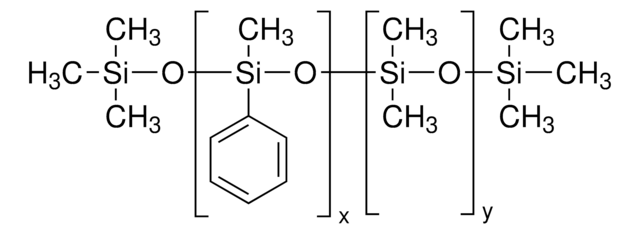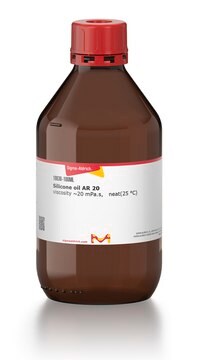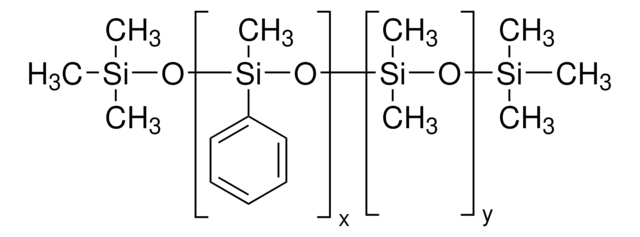50384
Silicone oil AP 150
viscosity ~150 mPa.s, neat(25 °C)
Synonym(s):
Silicone fluid
Sign Into View Organizational & Contract Pricing
All Photos(1)
About This Item
Recommended Products
General description
Silicone oil AP 150 is a conventional electrorheologic (ER) fluid. It was employed as an insulating medium during the poling of hard ferroelectric ceramics. Silicon oil is composed of a mixture of hydrophobic polymeric and monomeric compounds, containing silicon-oxygen bonds. Its physical and chemical characteristics have been reported. The utility of silicon oil as a vitreous substitute has been studied.
Application
Silicone oil AP 150 was used to prevent the water evaporation during rheological characterization of injectable polysaccharide system based on calcium alginate hydrogel and two dextran methacrylate derivatives. It may be used for the determination of chloroplast volume by the silicone oil filtering centrifugation technique.
Storage Class Code
10 - Combustible liquids
WGK
WGK 3
Flash Point(F)
437.0 °F - closed cup
Flash Point(C)
225.00 °C - closed cup
Personal Protective Equipment
dust mask type N95 (US), Eyeshields, Gloves
Choose from one of the most recent versions:
Already Own This Product?
Find documentation for the products that you have recently purchased in the Document Library.
Customers Also Viewed
Silicone Oil: Different Physical Proprieties and Clinical Applications.
Barca F, et al.
BioMed Research International, 2014 (2014)
Poling of hard ferroelectric PZT ceramics.
Kamel TMand de With G.
J. Eur. Ceram. Soc., 28(9), 1827-1838 (2008)
L Pescosolido et al.
European biophysics journal : EBJ, 39(6), 903-909 (2009-03-28)
A novel injectable polysaccharide system based on calcium Alginate (Ca-Alg) hydrogel and two Dextran methacrylate derivatives (DexMA) was recently developed. The resulting Interpenetrating Polymer Network showed a synergistic mechanical behavior that can be exploited to target the hydrogel properties towards
F Aliotta et al.
Physical review. E, Statistical, nonlinear, and soft matter physics, 87(6), 062304-062304 (2013-07-16)
The influence of interactions between particle surface and host fluids in electrorheological suspensions is explored. It is observed that dispersions of nanosized particles of titania in octanoid acid exhibit an anomalously large electrorheologic effect when compared with a similar dispersion
S P Robinson
Plant physiology, 79(4), 996-1002 (1985-12-01)
Spinach leaf chloroplasts isolated in isotonic media (330 millimolar sorbitol, -1.0 megapascals osmotic potential) had optimum rates of photosynthesis when assayed at -1.0 megapascals. When chloroplasts were isolated in hypertonic media (720 millimolar sorbitol, -2.0 megapascals osmotic potential) the optimum
Our team of scientists has experience in all areas of research including Life Science, Material Science, Chemical Synthesis, Chromatography, Analytical and many others.
Contact Technical Service




